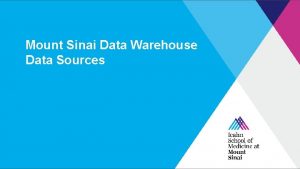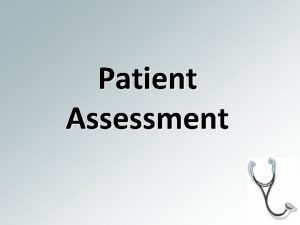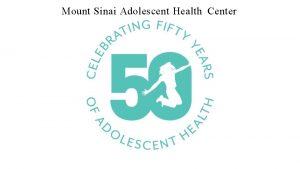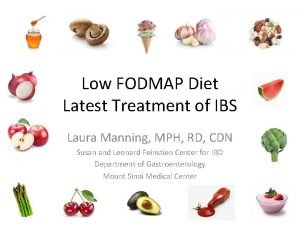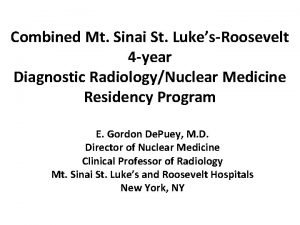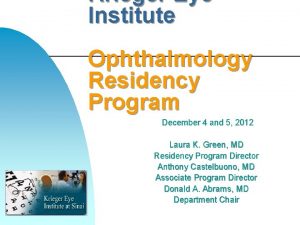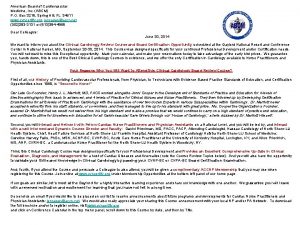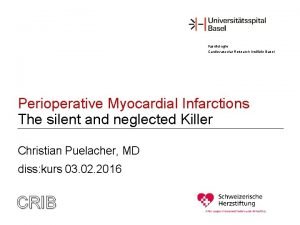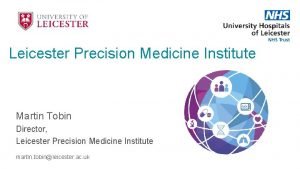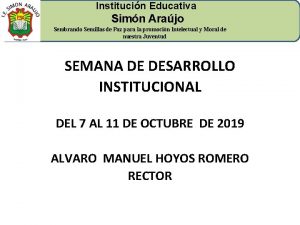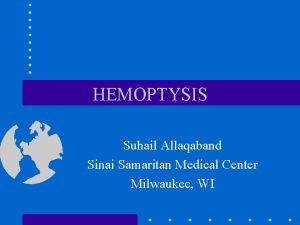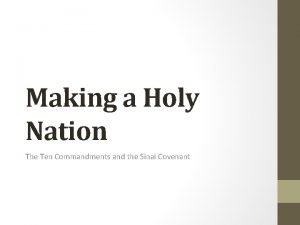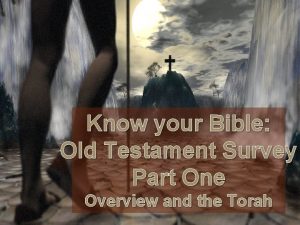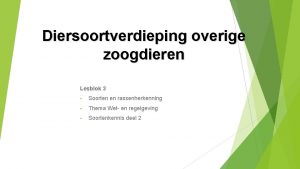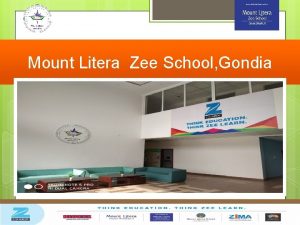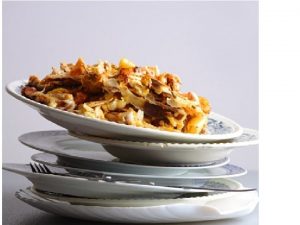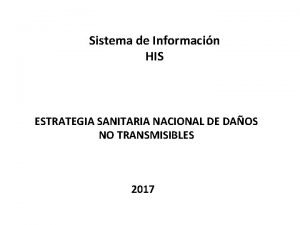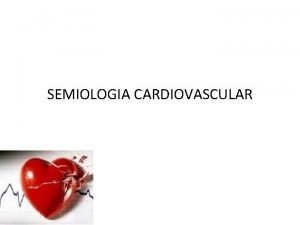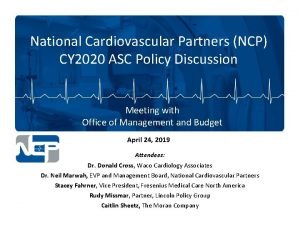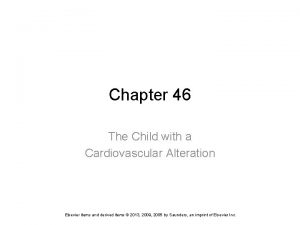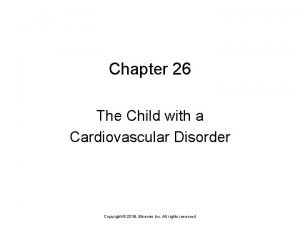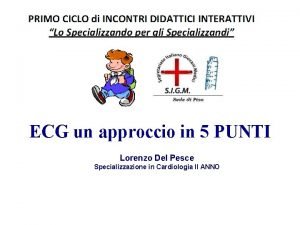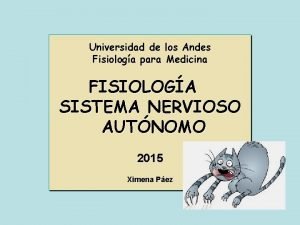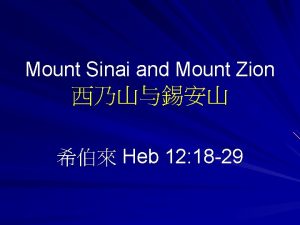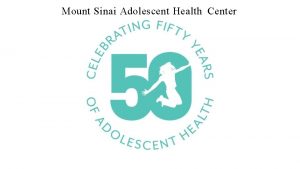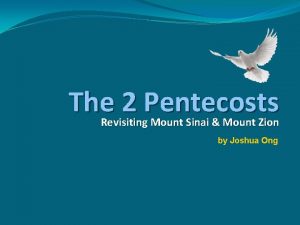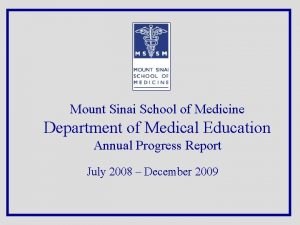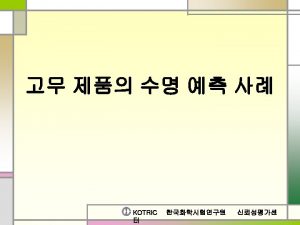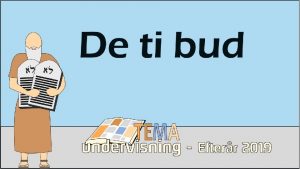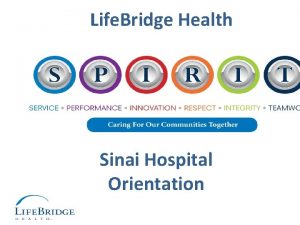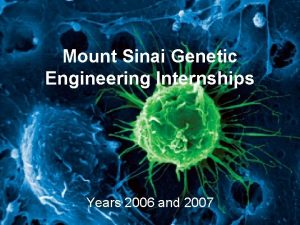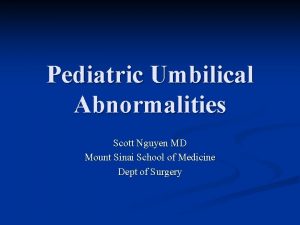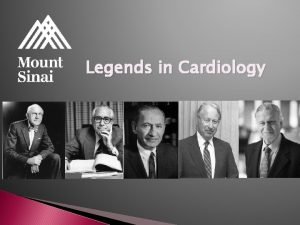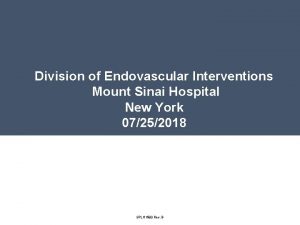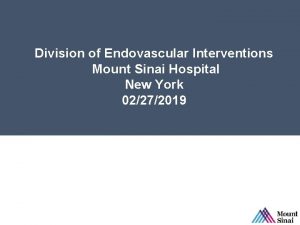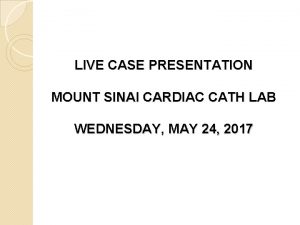The Cardiovascular Institute Mount Sinai School of Medicine

























































- Slides: 57

The Cardiovascular Institute Mount Sinai School of Medicine, New York Vulnerable Plaque + Vulnerable Blood = High-Risk Patient Juan Jose Badimon, Ph. D Professor of Medicine Director, Cardiovascular Biology Research Laboratory Facultad de Medicina Tucumán, Argentina Abril 26 th, 2006

Plaque - Blood - High Risk Patient Vulnerable (High-Risk) Plaque + Vulnerable (High-Risk) Blood = High-Risk (Vulnerable) Patient

Plaque - Blood - High Risk Patient Vulnerable (High-risk) Plaque

Atherosclerosis Progression

Fibrinolysis Coagulation TF + VIIa Blood Fibrin Plasminogen TF: VIIa FDP Prothrombin Plasmin Xa Thrombin Fibrinogen Lumen Platelets aggregation t. PA PAI-1 Macrophages adhesion/migration M-CSF NO PGI 2 Tx. A 2 NO CAMs Endothelium NO SMC contraction Normal Endothelium TF MMPs CRP MCP-1 VEGF TF ET-1 Media SMC relaxation Fibrin ET-1 SMC migration & proliferation Dysfunctional Endothelium Corti R and Badimon JJ Curr Opin Lipidol. 2001; 12: 629 -37 ATHEROSCLEROSIS

Coagulation Blood Flow TF + VIIa TF: VIIa Prothrombin PAI-1 t. PA Thrombin Fibrinogen Fibrinolysis Lumen Xa Platelets Aggregation Fibrin Tx. A 2 TF TF MMPs Tx. A 2 Endothelium Media Tx. A 2 ET-1 Smooth Muscle Cells (SMC) ET-1 SMC Contraction Dysfunctional Endothelium Corti R and Badimon JJ Curr Opin Lipidol. 2001; 12: 629 -37 ATHEROTHROMBOSIS

Atherosclerosis vs Atherothrombosis Atherosclerosis Progression Atherothrombosis

Ethiopathogenesis of Acute Coronary Syndromes

Major Clinical Manifestations of Atherothrombotic Diseases • Ischemic stroke • Transient ischemic attack • Myocardial infarction • Angina pectoris (stable, unstable) • Intermittent claudication • Critical limb ischemia, rest pain, gangrene, necrosis

Cost of Coronary Heart Disease United States: 2002 Hospital/Nursing Home $41. 8 billion Physicians/Other Professionals $8. 6 billion Home Health Care $1. 6 billion Drugs/Other Medical Durables $6. 2 billion Indirect Costs $53. 6 billion Direct Costs $58. 2 billion Total Cost = $111. 8 billion American Heart Association. 2002 Heart and Stroke Statistical Update. 2001.

Not all Atherosclerotic lesions are equal Falk E. 2006 JACC ; 47: C 7 -C 13

Stenotic Severity and CVD Falk E et al; Circulation 1995

Vulnerable Atherosclerotic Lesion Falk E. 2006 JACC ; 47: C 7 -C 13

Definition of Vulnerable Plaque Pathologist: mildly stenosed (50%) > 40% of their volume lipid-rich material thin fibrotic cap Cell Biologist: Proportion of SMC and Inflammatory cells Macrophage-rich lesions being more vulnerable Clinician: Those lesions triggering an ACS, independently of biochemical, cellular composition or location. High-risk lesions?

Is this a Vulnerable Lesion ? ? ?

Is this a Vulnerable Lesion ? ? ? Imaging MRI MDCT IVUS

Coronary Plaque Remodeling Compensatory Expansion outluminal plaque growth Normal Vessel Minimal CAD Moderate CAD Glagov S et al. NEJM 1987; 316: 1371 Expansion Overcome: Lumen Narrows Severe CAD

Angiography vs IVUS at multiple sites in an angiographically normal artery Nissen S et al 2002

IMAGING MODALITIES Lumen Wall Artery Angiography +++ - All +++ IVUS +++ ++ Co, Ca, Per B-mode doppler +++ + TEE +++ Ultrafast CT EBCT Nuclear Scintigraphy MRI Invasive Radiation Time Cost ++ ++ +++ +++ Ca, Per - - + + + Ao, Co Prox -, ? - ++ ++ +, ? Mostly Cor - ++ + +, ? Co, Ca, Per - +++ ++ +++ All (claust) - +++ ? Ao. - Aorta Co. - Coronaries Ca. - Carotids Per. - Peripherals

Clinical Event THROMBOSIS 30 -20 % PLAQUE EROSION 70 -80 % PLAQUE RUPTURE

Thrombotic Factors and Arterial Beds Coronaries Carotids Peripherals Plaque Disruption Rheology Blood Thrombogenicity +++ ++ +++ Virchow’s triad

Plaque - Blood - High Risk Patient + Vulnerable (High-risk) Plaque Vulnerable (High-Risk) Blood = High-Risk (Vulnerable) Patient

“ Vulnerable /Hyper-reactive” Blood Several risk factors correlate with hyperreactive blood. These factors may contribute to the clinical presentation after plaque disruption “Classic” Diabetes Smoking Hyperlipidemia Inflammation/ Apoptosis/ Infection? Cathecholamines Fibrinogen Lp(a) Homocysteinemia Factor V Leiden Platelet polymorph Shear rate Genetic Protein deficiencies (AT III, Prot C or S) Hypercoagulable state ( FVII, F 1. 2, FPA) Hypofibrinolytic state ( PAI-1, t-PA, u-PA) “Not so-classic” Depression Circulating TF activity Stress

TF Pathway and its potential inhibition TF + VIIa TFPI TF: VIIa X Xa IX IXa + + Va VIIIa Xa: Va Prothrombin VIIIa: IXa + Va Thrombin

Human plaques thrombogenicity is modulated by their content in Tissue Factor Fernandez-Ortiz et al. JACC 1994 Toschi V et al. Circulation 1997

Blood Borne - Tissue Factor Thrombus formation is inhibited by the systemic administration of an anti-TF antibody Giesen P et al. PNAS 1999; 96: 2311

Risk factors and circulating TF activity 400 (pmol FXa/L) Tissue Factor activity 500 300 200 100 0 Control Smokers Hyperlipidemic Diabetics Sambola A. Circulation 2003; 107: 973 -979

Sambola Circ. 2003 Glycemic Improvement No Glycemic Improvement Circulating TF activity Blood Thrombogenicity Glycemic Control & Blood Thrombogenicity

Tissue Factor: a key player for thrombosis and inflammation Two versions of a similar story: 1. - The classical 2. - The newer Juno, the two-faced God

TF Circulates in Blood: Possible Cellular Sources BLOOD HEART myocardial ischemia monocyte myocyte TF fibroblast PMN macrophage AT plaque lipid core Endothelial cell SMC VESSEL WALL

Apoptosis CD 40 L/CRP Atherosclerosis Inflammation Tissue factor micro-particles Thrombosis Aggregated Platelets ICAM-1 IL-6 ACS CV Risk Factors The Inflammation-Thrombosis Link PDGF Thrombin IL-1 TF MMP Clinical evidence: Septic shock Inflammation subsequent to bacterial endotoxin induces endothelial TF and PAI-1 expression leading to thrombotic complications (DIC)

Antithrombotic Therapy Inhibitors of the intrinsic pathway HEPARIN WARFARIN LOW MOLECULAR WEIGHT HEPARINS DIRECT THROMBIN INHIBITORS Antiplatelet agents ASPIRIN TICLOPIDIN, CLOPIDOGREL (±ASA) GP IIb/IIIa RECEPTOR ANTAGONISTS DIRECT THROMBIN INHIBITORS Other Approaches: THROMBOLYTICS, ANTI IX, P 2 T and TX-ANTAGONISTS Antithrombotic agents have reduced approx. 20% of ACS in CAD patients (BMJ 2002; 324: 71 -86).

Antithrombotic Therapy Inhibitors of the intrinsic pathway HEPARIN WARFARIN LOW MOLECULAR WEIGHT HEPARINS DIRECT THROMBIN INHIBITORS Antiplatelet agents ASPIRIN TICLOPIDIN, CLOPIDOGREL (±ASA) GP IIb/IIIa RECEPTOR ANTAGONISTS DIRECT THROMBIN INHIBITORS Inhibitors of Tissue Factor Pathway TFPI TAP Direct Thrombin Inhibitors Other Approaches : Inhibitors Of Clotting Factors VIIa and/or Xa THROMBOLYTICS, ANTI IX, P 2 T ANTAGONISTS, TX-ANTAGONISTS

Thrombosis and Atherosclerotic Lesions Smooth Muscle Cells Macrophages Extracellular lipid Cholesterol Clefts Calcified Plaque Thrombus Healed thrombus Collagen Virmani R. ATVB 2000; 20: 1262

ATHERO-THROMBOTIC DISEASE MAN LIVES WITH ATHEROSCLEROSIS BUT DIES FROM THROMBOSIS

Clopidogrel - Clopidogrel is superior to ASA -Requires hepatic metabolization that results in delayed onset of action (unless using Loading doses). Clopidogrel + ASA combination is considered the treatment of choice for ACS patients - Several large trials have clearly established that Clop+ASA combination is safe and more effective than either agent alone. -Irreversible platelet inhibition causes persistent antithrombotic effects (Ying-Yang). -Commonly used “maintenance” dose (75 mg/day) only inhibits 40 -50% of ADP induced platelet aggregation. - Clopidogrel-treated patient should wait several days prior undergoing surgical procedures.

What’s new in the antithrombotic horizon?

P 2 Y 12 Inhibitors Clopidogrel; Sanofi/BMS Orally active fast acting (loading) long-lasting irreversible Prasugrel CS-747: Sankyo Orally active fast acting irreversible AZD 6140 (AZ, ARC-66941) orally active fast acting reversible (24 hrs)

Study on the safety and tolerability of AR-C 69931 N=39 CAD patients 4 mg/Kg/min x 69 hour Storey R et al. Thromb Haemost 2001; 85: 401

Additive Effect of AZD 6140 to Clopidogrel 75 mg/day AZD 1 m. M; 523 ng/m. L WB impedance 10 m. M ADP

Clinical Trials with new PY 12 Inhibitors JUMBO - TIMI 26 (Circulation 2005; 111: 3366 -73) Prasugrel vs Clopidogrel in PCI. The study showed similar safety and tolerability. Effectiveness being tested in the TRITON. AZD 6140 vs Clopidogrel in stable CAD DISPERSE-1: Greater and more consistent platelet inhibition than Clopidogrel (ESC-2005). DISPERSE-2 Similar safety and tolerability than Clopidogrel (AHA 2005)

AZD 6140 AR-C 6993 Cangrelor Is an oral, potent, selective and competitive ADP receptor antagonist via P 2 Y 12 receptor. Will be “the lower the better” like in lipid lowering? Maximal effect achieved within 2 hours with a or half-life of approx 8 hours. the more powerful the more At 200 mg dose abolishes ADP-platelet aggregation bleeding? up to 12 hours. Will be “theblocks lower the better” Fully and reversibly ADP-platelet aggregation.

CHARISMA Trial Following the CURE (UA patients) and COMMIT (MI patients) the event-driven CHARISMA trial, was designed to test whether the benefits of Clop+ASA vs ASA would also apply to a broad atherosclerotic population 15, 603 patients with a F/U of 28 months. The results showed no difference in primary end-points but a significant increase in bleeding complications. IMPORTANT: Do not stop Clop+ASA treatment in stented patients.

Lessons Learned from CHARISMA Primary Prevention: ASA seems to be enough. Secondary Prevention: Clop+ASA in high-risk patients offers more robust benefits. After Stenting: Clop+ASA should be given for one year. It should be maintained in patients with recurrent ACS or strokes w/o history of bleeding. Otherwise ASA alone should be enough. Always use “clinical common sense” based on individual risks

Tenase complex F Ixa F VIIIa FX F Xa FXa Potential therapeutic targets F VIIa TF: FVIIa Tissue factor Prothrombinase complex F Xa F Va Prothrombin Thrombin

FDA’s did not approve Exanta Despite all the clinical data and excitement generated by EXANTA; it was not approved by the FDA (September 10 th, 2004) The major concern was the high incidence of “high risk” adverse events associated with long-term use. 1 in each 2300 patients will develop severe liver toxicity resulting in death. The committee requested further assessment of the liver toxicity, cardiovascular events and incidence of bleeding observed in the studies. Inability to identify patient at risk for liver toxicity

Future Of Direct Thrombin Inhibitors Ximelagatran was thought to be a significant break-through in antithrombotic therapy but it as not approved by the FDA. How will the FDA’s decision affect the development of new thrombin inhibitors? Would it result in a “delay” or the “death” of antithrombins in general ? Certainly, it has triggered and accelerated the development of other P 2 Y 12 and FXa inhibitors

What’s new in the TF pathway inhibition Factor Xa Inhibitors Parenteral agents: Fondaparinux Idraparinux 1 DX 9065 a Otamixaban Orally Active agents: Raxazaban/Apixaban Bay 59 -7939 Lilly 517717 PD-5348292 (Pfizer) DU-697 (Sankyo-Daiichi) Factor II Inhibitors Parenteral agents: Lepidurin Bivalirudin Argatroban Orally Active agents: Ximelagatran Dabigatran 1 VG trial DVT positive VG trial PE negative AF trial stopped bleeding

Idraparinux (San. Org 34006) • Idraparinux is a synthetic analogue of Fondaparinux (Arixtra) which binds with high affinity to AT (Kd = 1. 2 n. M) resulting in the formation of a highly potent and selective inhibitor of coagulation factor Xa. It is targeted to chronic treatment of venous thrombosis • Idraparinux was well tolerated after a single iv (up to 14 mg) or sc (2 and 10 mg) administration in healthy young male volunteers. Extended half life up to one-week

Fondaparinux Mechanism of Action

Fondaparinux - VTE Clinical Trials Orthopedic Surgery Venous Thromboembolism: effective (55%) and equally safe (2. 7 vs 1. 7% bleeds) than LMWH ACS: (Pentalyse Thrombolysis vs UFH) and Pentua (Enox) comparable effectiveness and safety Bauer K et al. Curr Opin Pulm Med. 2002; 8: 398 -404 Koopman M, Buller H. J Intern Medicine 2003; 254: 335

OASIS 5: Fondaparinux vs Enoxaparin in ACS 20, 078 ACS patients randomized to Fondaparinux (2. 5 mg/d) or Enoxaparin (1 mg/Kg twice/day) for 6 days. No significant difference on primary end-points at short time (9 days), but Fondaparinux had lower bleeding leading to reduced mortality at 90 and 180 days (p<0. 02). NEJM 2006; 354: 1464 -1476

Antithrombotic Effects of Razaxaban an orally active FXa Inhibitor

Antithrombotic Effects of Razaxaban, a FXa Inhibitor 3 hours 12 hours 25 mgs 80± 7 25± 7 100 mgs 325± 42 91± 11 Plasma levels (ng/ml) There is dose-response pattern In their antithrombotic and anticoagulation activities

SAFE RANGE Thrombus Bleeding Thrombosis The Ideal Antithrombotic Bleeding Dose (concentration) of Anticoagulant

Luna Tucumana No le canto a la Luna porque alumbre mas que el Sol, le canto porque ella sabe de mi largo caminar En algo nos parecemos Luna de la soledad Yo voy andando y cantando que es mi modo de alumbrar Ay, Luna tucumana, tamborcito calchaki, Mas cuando salga la Luna cantaré, cantaré a mi Tucuman querido cantaré, cantaré. compañera de los gauchos por la senda del tapir

Muchas Gracias por su atención
 Bislr medical groups
Bislr medical groups Mount sinai intranet
Mount sinai intranet Pulse site
Pulse site Mount sinai adolescent clinic
Mount sinai adolescent clinic Gos foods fodmap
Gos foods fodmap Mt sinai nuclear medicine
Mt sinai nuclear medicine Kennedy krieger eye institute
Kennedy krieger eye institute American board of cardiovascular medicine
American board of cardiovascular medicine Cardiovascular research institute basel
Cardiovascular research institute basel Martin tobin leicester
Martin tobin leicester Dr. martin tobin
Dr. martin tobin Duke translational medicine institute
Duke translational medicine institute Sinai simon araujo
Sinai simon araujo Sinai samaritan
Sinai samaritan Berg der gesetzgebung sinai
Berg der gesetzgebung sinai Gods commandments
Gods commandments Kitab yang diturunkan di bukit sinai adalah
Kitab yang diturunkan di bukit sinai adalah özel haklar nelerdir
özel haklar nelerdir Old testament survey part 1
Old testament survey part 1 Vivity hmo cedars sinai
Vivity hmo cedars sinai Monte sinai jesus
Monte sinai jesus Gekruin
Gekruin Mount litera zee school ahmednagar
Mount litera zee school ahmednagar Mount litera zee school books solutions class 3
Mount litera zee school books solutions class 3 Mount litera zee school pusad
Mount litera zee school pusad Mount litera zee school complaints
Mount litera zee school complaints Mount litera zee school chandrapur
Mount litera zee school chandrapur Mount litera zee school besa nagpur
Mount litera zee school besa nagpur Litera gear
Litera gear Mount litera zee school balaghat
Mount litera zee school balaghat Mount keira demonstration school
Mount keira demonstration school Opening prayer rosary
Opening prayer rosary Mount litera zee school chandrapur
Mount litera zee school chandrapur Mount baker middle school calendar
Mount baker middle school calendar Mchr school
Mchr school Jindal mount litera zee school
Jindal mount litera zee school Mount grace school uniform
Mount grace school uniform Capillary bed labeled
Capillary bed labeled Riesgo cardiovascular por perimetro abdominal
Riesgo cardiovascular por perimetro abdominal Azoulay maniobra
Azoulay maniobra What makes up the cardiovascular system
What makes up the cardiovascular system Rias cardiovascular
Rias cardiovascular Cushing reflex
Cushing reflex Fresenius national cardiovascular partners
Fresenius national cardiovascular partners Totally tubular dude
Totally tubular dude Heart rate during exercise
Heart rate during exercise Structure of blood vessels
Structure of blood vessels Cengage learning heart diagram
Cengage learning heart diagram Chapter 46 the child with a cardiovascular alteration
Chapter 46 the child with a cardiovascular alteration The child with a cardiovascular disorder chapter 26
The child with a cardiovascular disorder chapter 26 Chapter 25 assessment of cardiovascular function
Chapter 25 assessment of cardiovascular function Figure 11-8 arteries
Figure 11-8 arteries Chapter 11 the cardiovascular system figure 11-10 answers
Chapter 11 the cardiovascular system figure 11-10 answers Chapter 11 the cardiovascular system
Chapter 11 the cardiovascular system Lesson 11 cardiovascular system
Lesson 11 cardiovascular system Battiti ectopici ventricolari forum
Battiti ectopici ventricolari forum Receptores sensoriales
Receptores sensoriales Cardiorespiratory system includes
Cardiorespiratory system includes
